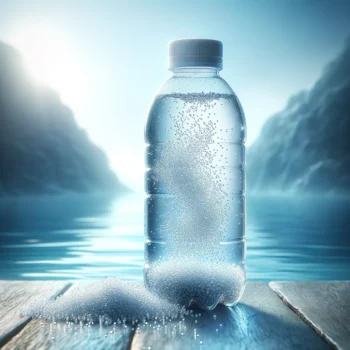
February 13th, 2024
By Lily Anderson
Staff Writer for Wake Up World
In the era of increasing environmental awareness, the ubiquitous presence of microplastics has raised concerns globally. These minute particles, a byproduct of plastic breakdown, have infiltrated various ecosystems, from polar ice to soil, water, and even our food. The focus intensifies on bottled water, a commodity widely consumed, as recent advancements in technology shed light on an even smaller culprit: nanoplastics.
The Nanoplastic Frontier
In a groundbreaking study published in the Proceedings of the National Academy of Sciences, researchers have delved into the poorly understood realm of nanoplastics. These microscopic particles, offspring of their larger counterparts, microplastics, have been identified and quantified in bottled water for the first time. Astonishingly, an average liter contained a staggering 240,000 detectable plastic fragments, revealing a magnitude 10 to 100 times greater than previous estimates.
Beizhan Yan, an environmental chemist at Columbia University’s Lamont-Doherty Earth Observatory, emphasized the significance of this discovery, stating, “This opens a window where we can look into a world that was not exposed to us before.”
The Invisible Threat: Nanoplastics’ Infiltration
Nanoplastics, being even smaller than microplastics, possess the alarming ability to pass through intestines and lungs, directly entering the bloodstream. They can travel to vital organs such as the heart and brain, invade individual cells, and even cross the placenta, impacting unborn babies. Medical scientists are racing to understand the potential health implications on various biological systems.
The lead author of the study, Naixin Qian, a Columbia graduate student in chemistry, highlighted the previous lack of knowledge in this domain, stating, “Toxicity studies were just guessing what’s in there.”
Unveiling the Culprits: Plastic Invasion
With worldwide plastic production approaching 400 million metric tons annually, the issue is far-reaching. Plastics, unlike organic matter, do not benignly break down but continuously divide into smaller particles. Microplastics, defined as fragments ranging from 5 millimeters to 1 micrometer, now have an even smaller sibling – nanoplastics, measured in billionths of a meter.
The study, utilizing stimulated Raman scattering microscopy, revealed that nanoplastics accounted for 90% of the particles found in bottled water. The researchers identified seven common plastics, including polyethylene terephthalate (PET) and polyamide, with PET being outnumbered by nylon, possibly originating from plastic filters used in water purification processes.
The Dark Side of the Nano World
Disturbingly, the seven plastic types identified in the study represented only about 10% of all nanoparticles found, leaving the composition of the rest unknown. If these are all nanoplastics, the numbers could potentially be in the tens of millions per liter, posing a complex challenge for distinguishing them from natural organic matter.
Beyond Bottled Water: The Vast World of Nanoplastics
The researchers are expanding their focus beyond bottled water, intending to explore tap water and wastewater. Beizhan Yan is leading a project studying microplastics and nanoplastics in laundry wastewater, revealing millions per 10-pound load. Collaborating with environmental health experts, the team aims to measure nanoplastics in human tissues, examining developmental and neurologic effects.
As Wei Min, a Columbia biophysicist and co-inventor of the microscopy technique used in the study, aptly puts it, “It’s not size that matters. It’s the numbers, because the smaller things are, the more easily they can get inside us.”
In conclusion, the revelation of nanoplastics in bottled water signals a new frontier in plastic pollution research, urging a comprehensive examination of their impact on our health and the environment. As we navigate this plastic-infested landscape, awareness and responsible consumption become crucial in safeguarding our planet and future generations.
Reference:
- Naixin Qian et al. Rapid single-particle chemical imaging of nanoplastics by SRS microscopy. PNAS, 2024 DOI: 10.1073/pnas.2300582121
About the author:
Lily Anderson is a passionate wordsmith and dedicated explorer of cutting-edge scientific inquiries. Fuelled by a thirst for knowledge, she skilfully transforms intricate ideas into relatable tales, inviting readers to embark on a captivating expedition of revelation. Lily’s efforts play a crucial role in bridging the gap between experts and the wider public, evoking a sense of awe and encouraging insightful discussions about groundbreaking scientific advancements.

If you've ever found value in our articles, we'd greatly appreciate your support by purchasing Mindful Meditation Techniques for Kids - A Practical Guide for Adults to Empower Kids with the Gift of Inner Peace and Resilience for Life.
In the spirit of mindfulness, we encourage you to choose the paperback version. Delve into its pages away from screen glare and notifications, allowing yourself to fully immerse in the transformative practices within. The physical book enriches the learning process and serves as a tangible commitment to mindfulness, easily shared among family and friends.
Over the past few years, Wake Up World has faced significant online censorship, impacting our financial ability to stay online. Instead of soliciting donations, we're exploring win-win solutions with our readers to remain financially viable. Moving into book publishing, we hope to secure ongoing funds to continue our mission. With over 8,500 articles published in the past 13 years, we are committed to keeping our content free and accessible to everyone, without resorting to a paywall.







